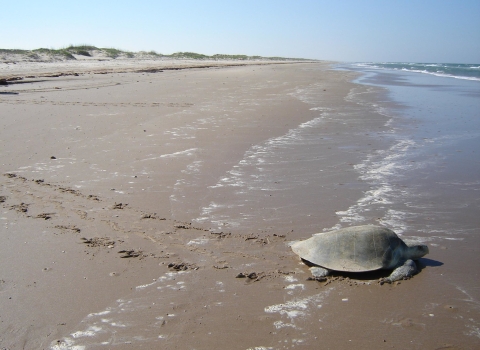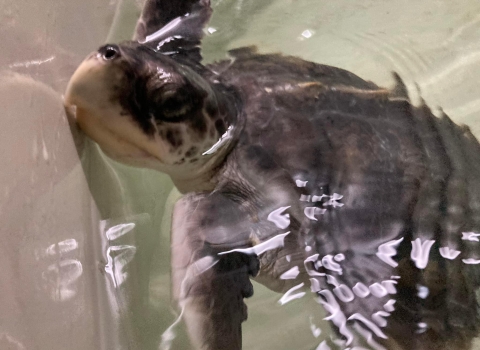With sea turtle nesting season beginning on the Texas coast, the U.S. Fish and Wildlife Service is urging everyone using Texas beaches to do their part to help detect and protect threatened and endangered sea turtles on the beach. This includes the endangered Kemp's ridley sea turtle, as well as the threatened loggerhead and green sea turtles.
“The public can help us protect these imperiled species by keeping an eye out and reporting all nesting sea turtles, their nests, and hatchlings from late March through September,” said Mary Kay Skoruppa, U.S. Fish and Wildlife Service Sea Turtle Coordinator for Texas. “We also ask that visitors drive slowly and carefully on beaches so that vehicles do not inadvertently collide with nesting turtles or emerging hatchlings. By working together, we can help ensure these species continue to find safe nesting conditions on the Texas coast now and into the future.”
To help ensure the survival of nesting sea turtles and eggs, biologists and volunteers will patrol Texas beaches from April through July. The Service, along with the National Park Service, Texas Parks and Wildlife Department, Texas A&M University at Galveston, the University of Texas Marine Science Institute, Sea Turtle, Inc., and Turtle Island Restoration Network will be working together to coordinate a response when a nesting sea turtle, tracks, or nest is found.
Beachgoers who encounter a nesting sea turtle should report it immediately by calling 1-866-TURTLE-5 (1-866-887-8535). After reporting the sighting, it is crucial to remain on-site until a biologist arrives. If it isn’t possible to wait, mark the area gently with natural debris, such as small pieces of wood, making a large circle around the nest without covering it, to help biologists locate it later.
When a nesting sea turtle is spotted, keeping a distance of 100 feet away is essential; do not disturb the turtle or its nesting site. It is vital that the female turtles are allowed to return to the water after laying their eggs.
The Kemp’s ridley sea turtle, the smallest of the sea turtle species, measures about two feet in length and can weigh up to 100 pounds. They are known for nesting during the day, while the green and loggerhead sea turtles nest less frequently along the Texas coast, typically at night.
This year marks the 47th anniversary (1978-2025) of the bi-national conservation efforts for the Kemp’s ridley sea turtle. In 1947, the only known nesting site for Kemp’s ridley turtles was discovered on a single beach stretch near Rancho Nuevo, Mexico. However, over the next four decades, this population suffered a catastrophic decline of 99.4% in nesting numbers. In response, the Service, along with partner agencies, initiated a collaborative international project in 1978 to focus on nest protection in the U.S. and Mexico, enforce regulations on turtle excluder devices for commercial fishing trawlers, and establish a second nesting colony at Padre Island National Seashore in Texas.
Cooperative efforts continue to help the Kemp’s ridley sea turtle population. In 2024, 340 Kemp’s ridley nests were found in Texas. The largest number recorded in Texas since 1978 was in 2017, when 353 nests were documented. The Kemp’s ridley sea turtle remains one of the most endangered species of sea turtle in the world; therefore, bi-national conservation efforts must continue to fully recover the species.






